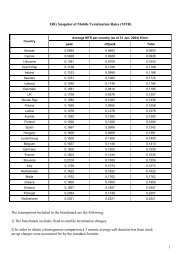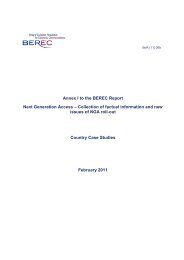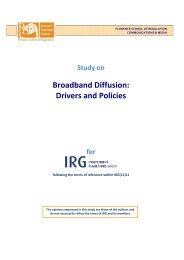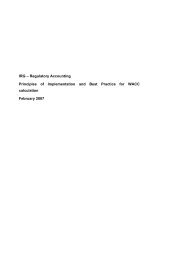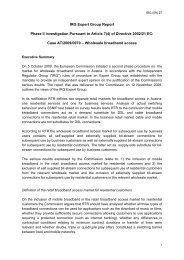16 Rev2b NGA Opinion Supplementary doc - IRG
16 Rev2b NGA Opinion Supplementary doc - IRG
16 Rev2b NGA Opinion Supplementary doc - IRG
Create successful ePaper yourself
Turn your PDF publications into a flip-book with our unique Google optimized e-Paper software.
ERG (07) <strong>16</strong>rev2b <strong>NGA</strong> <strong>Opinion</strong> <strong>Supplementary</strong> Doc 7 / 69<br />
Question Chapter 2: Do the scenarios describe the relevant roll-out<br />
alternatives for <strong>NGA</strong>?<br />
Consultation Comments<br />
The Consultation Document distinguishes between two main scenarios - Fibre to the Cabinet<br />
and Fibre to the Home / Fibre to the Building – as these broadly appear to be the most relevant<br />
cases in several Member states. The majority of comments considered the distinction<br />
between these two scenarios appropriate (Arcor, BSG, FTTH Council Europe, ONI, QSC,<br />
Silver Server, Sonaecom, TDC, Tele2). A more critical view was taken in particular by the<br />
incumbents and cable stakeholders (BT, Cable & Wireless, Corning, KPN, PT, TI, Telefónica).<br />
Their main point of criticism was that alternatives technologies (e.g. cable) are missing.<br />
Another incumbent (FT) considers FttB to belong to the FttCab-Scenario (similar<br />
ETNO).<br />
Besides these rather general points some specific issues referring either to the FttCab-<br />
Scenario (Chapter 2.2) or the FttH/B-Scenario (Chapter 2.3) were raised in the comments.<br />
Scenario I: Fibre to the Cabinet<br />
One comment considered FttCab a simplification (ECTA, similar Tele2), as incumbent’s<br />
passive metallic cable distribution systems being closer to the MDF are not always located in<br />
street cabinets but of placed in (e.g.) operators’ own small buildings or building’s cellars.<br />
Thus, ERG should apply a more open approach when addressing the issue of access to cable<br />
distribution systems, not limiting access to street cabinets only.<br />
The key characteristic of Scenario I is not the fact that fibre is brought lower in the network<br />
hierarchy. Instead, key characteristics are the new risks of spectral interference with ADSL2+<br />
deployed higher in the network architecture, and that there is a risk that dominant operators<br />
could undermine or breach the unbundling mandate (Tele2).<br />
Another stakeholder emphasized that there will be no clear FttCab scenario “for a very long<br />
time” because the roll-out will only be economical in some areas (ETP).<br />
Scenario II: Fibre to the Home / Fibre to the Building<br />
In one comment it is criticized that point-to-point fibre <strong>NGA</strong> is not considered (C&W). Another<br />
comment stressed that point to point FttH and point to multipoint FttH roll-outs are highly distinctive<br />
(PT).<br />
A competitor points out that currently “probably more point-to-point Ethernet is being rolled<br />
out than GPON (Tele2). This is attributed “to the fact that incumbent operators are lagging<br />
behind competitors and behind the publicly funded and the utility fibre networks. Thus, footnote<br />
39 is seen as overstating the importance of GPON. Moreover, the ERG is invited to further<br />
investigate wavelength access, in particular whether splitters could be utilized, enabling<br />
wavelength unbundling at higher levels in the network hierarchy.<br />
An incumbent considers the scenarios “reasonably comprehensive for fibre” (BT) and another<br />
comment considers FttB/H to be the sustainable long-run solution (FTTH Council<br />
Europe).



